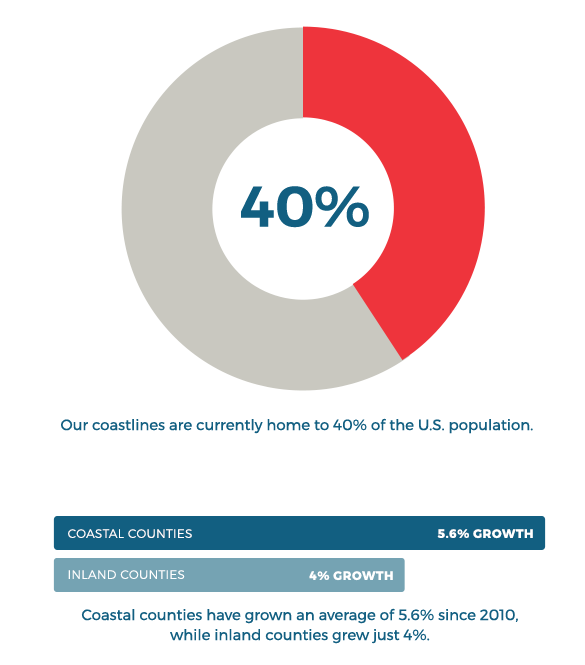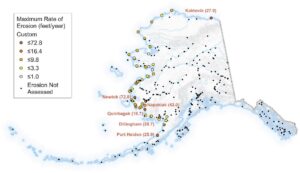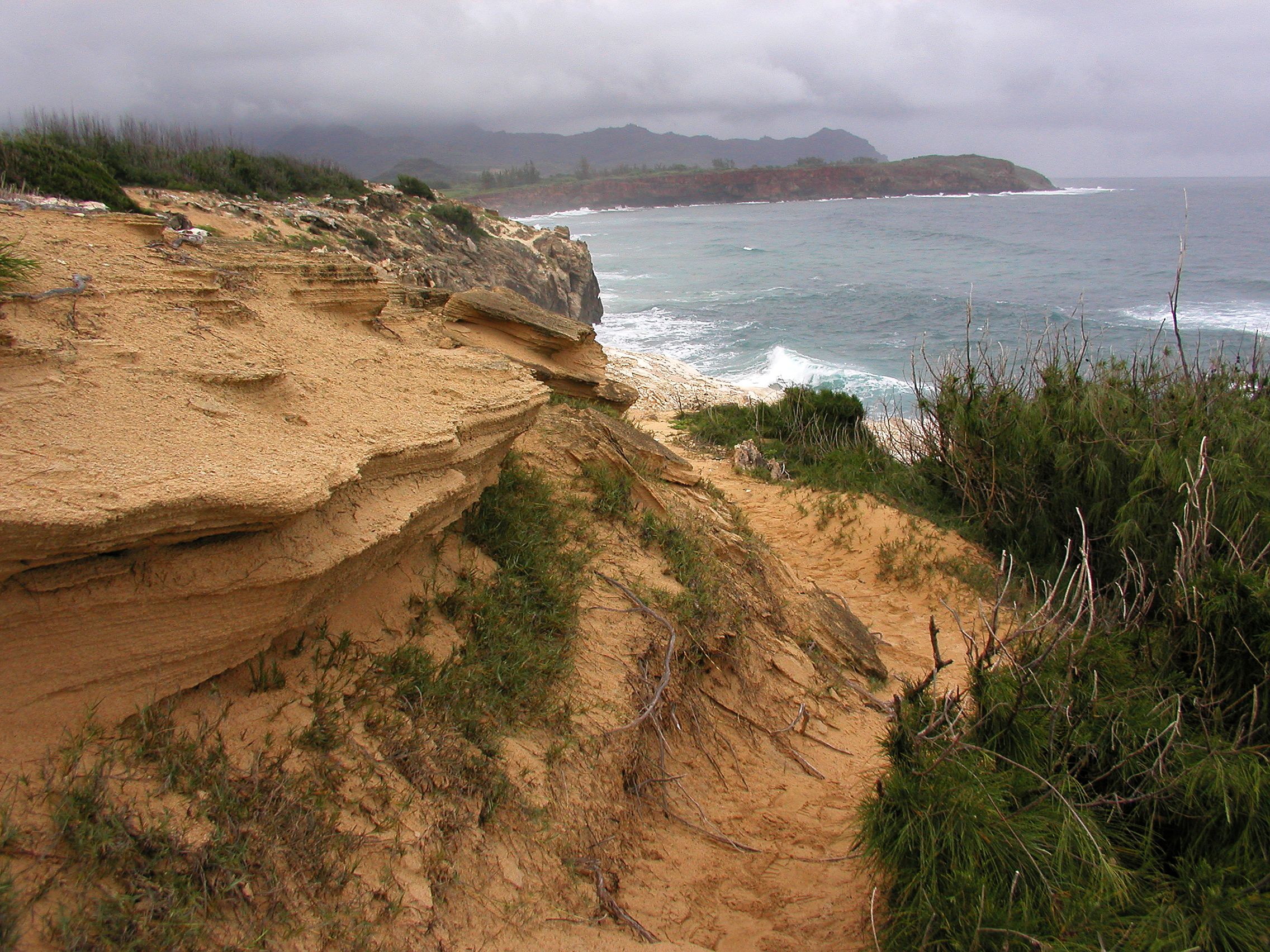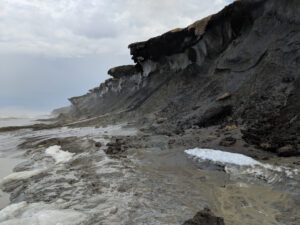Alaska Project Resources:

Beach-building (accretion) and erosion are natural processes. The desire to live and build structures on our coastlines exposes our homes, roads, commercial and industrial facilities, shipping ports, marinas, and other buildings to shoreline erosion.
Our coastlines are currently home to 40% of the U.S. population. There is a long trend of higher growth on the coasts. The coastal area of the U.S. is twice as developed as the rest of the country: 8.8%, versus 4.09% of the interior.
As global sea level rises, wave action and storm surge increase the likelihood of extensive coastal erosion. It is estimated that coastal erosion costs roughly $500 million per year for U.S. coastal property loss, including damage to structures and loss of land. As our climate continues to change, the increasing frequency of extreme weather threatens our shoreline communities.



Spanning 6,600 miles and accounting for approximately one-third of the entire U.S. coastline, Alaska’s coastal expanse is a haven for diverse marine and terrestrial wildlife. This rich biodiversity has nurtured the long traditions of subsistence hunting, fishing, and gathering deeply woven into the cultural fabric of Alaskan communities. In addition to its ecological and cultural importance, the coast is home to 83% of the State’s population and supports key economic sectors, including commercial fishing, tourism, and the extraction of natural resources.
However, Alaskans today face the challenge of safeguarding these exceptional landscapes from coastal erosion, which can cause the loss of land and habitat, undermine critical infrastructure, displace communities, and jeopardize economic industries.
Coastal erosion in Alaska diverges significantly from erosion patterns observed in the continental U.S. Fueled by rising temperatures, the combined forces of wave action, sea ice loss, glacial retreat, and permafrost thaw jeopardize the vast coastline composed primarily of soft, easily erodible sediment. The loss of sea ice, which previously served as a natural barrier, increases the power with which waves crash onto the coast accelerating erosion. The exposure of the once protected coastline, coupled with the instability of coastal bluffs from thawing permafrost, further increases Alaska’s vulnerability.
While Alaska is experiencing land loss at a rate second only to Louisiana, the stark contrast in erosion mechanisms underscores the need for region-specific approaches to understanding, managing, and mitigating coastal erosion. Alaskans are addressing coastal erosion through a combination of strategies, including implementing shoreline protection measures, relocating threatened communities, conducting research to better understand erosion dynamics, and advocating for policies that promote sustainable development and land use practices.


Where it is feasible, returning our coastal estuaries and shoreline to a natural, undeveloped state can increase the resilience to storms, flooding, erosion, and other threats to these communities. Coastal wetlands are well known to be natural sponges that absorb floodwaters, putting the brakes on destructive wave action, and mitigating coastal erosion. Natural shorelines buffer storm surges, sequester carbon and other pollutants, and support a healthy habitat for commercially and recreationally important fish species.
Living shorelines, soft shore protection, coastal revegetation, and other hybrid approaches are nature-based solutions to coastal erosion that can mimic nature while protecting your property and increasing critical habitat for marine species. Coastal restoration initiatives have the potential to replace erosive elements like seawalls or bulkheads with more sustainable features such as natural beaches, soft shore protections, salt marshes with oyster reef borders, or comparable structures. Furthermore, a study demonstrated that living shorelines achieved a nitrogen removal rate exceeding 50% from water, with further improvement observed as these sites matured.

Given the distinct mechanisms driving coastal erosion in Alaska, some conventional coastal restoration strategies may not be viable. Dedicated mapping and research initiatives led by scientists, government agencies, and local communities aim to develop strategies for shoreline protection and sustainable land-use practices to effectively address the challenges posed by coastal erosion.
With only 20% of the state accessible by roads and a short construction season, coastal restoration requiring large construction projects in Alaska can cost many times more than in the lower 48. Some communities are utilizing more affordable soft shoreline options including coastal revegetation and the construction of dynamically stable beaches.
Native plant species used in ways that address the specific needs and conditions of Alaska’s coastal regions can be used to restore and stabilize eroding coastlines. The Alaska Coastal Revegetation & Erosion Control Guide is a valuable resource that offers practical insights into combating coastal erosion in the unique and challenging environment of Alaska.
Dynamically stable beaches are a soft shoreline restoration option designed according to wave direction to maintain an equilibrium of sediment movement. Observations show that these restoration projects experience only minor damage after storm events and require minimal maintenance and cost significantly less than most rigid structures.
Erosion and flooding affect 87% of rural communities along Alaska’s rivers and coasts. In 2019, 27 Alaska Native villages were identified as highly vulnerable with several considering relocation. For these impacted communities, a community-based approach to risk assessments, adaptation planning, and managed retreat can mitigate impacts and protect cultural heritage.

We need your help to improve the Toolkit by completing our easy, 3-minute survey. Your insight is valuable to us.